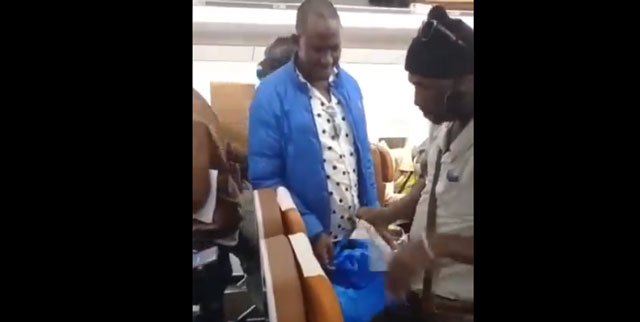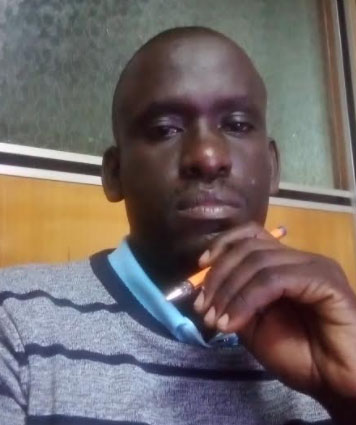
COMMENT | Samson Tinka | Last Friday night, Uganda Airlines flight to Dubai had some of its passengers engage in what I would descirbe as comedy. The drama had a one Paul Mubiru selling Nsenene ( fried long-horned grasshoppers) to his colleagues and other passengers on board.
The short stunt which was recorded by the perpetrators themselves, has attracted mixed reactions from Ugandans.
Whereas others find it normal and applauded the guys for being ‘real Ugandans’, others were angry that the guys had done something that might degraded the status of the national airline.
It was soon after reported in the media how Works and Transport Minister Gen Katumba Wamala called for suspension of Uganda airlines staff responsible for aircraft handling. The Nsenene comedy actors were also detained by Police when they returned to Uganda four days later.
Ugandans have wondered how such items – Nsenene – could be carried by anyone onboard. They have even imagined if the airline and its occupants are, or were safe.
What has followed are other fake graphics, have been shared on social media depicting Uganda airlines aircraft invaded by vendors of different products including chicken, roasted meat etc.
Anyway, Ugandans are known for dramatizing everything along the way and never mindful the impact it can create both economically, socially and politically. Strange that Ugandans derive happiness from such comedies and make statements where they are not subject matter experts.
A number of questions have been paused about this incident and I will try to give it perspective.
- Was it a security or safety breach?
- Was AVSEC- Aviation security responsible for this incident?
- Should CAA-AVSEC team have stopped the passenger from travelling with his carryon luggage of Nsenene?
- Did cabin crew team respond properly?
- Was the passenger in breach of any policy, procedure, system, standard or any good practice?
Was there any safety or security breach?
Air transport is the safest and most secure means of transport all over the world. This is due to high standards set and maintained by aviation players. From 1948 Geneva convention and subsequent conventions continue to guide the aviation industry on the standards and recommended practices commonly termed as SARPs. Outside these conventions, there are ICAO 19 annexes that specifically speak to each area that aviation deemed vital. They range from Annex 1 – Personnel Licensing to Annex 17, 18 and 19, that talk to Security, safe transportation of dangerous goods by air, and safety management.
Annex 17 and 18 will address the grasshopper circus fully and will answer some of the five paused questions in this article.
Annex 18
Annex 18 deals with dangerous goods and which goods are forbidden or how they are transported.
Dangerous goods are classified in 9 classes. A deep dive on the DGs, grasshoppers don’t fall anywhere in terms of quantities and specifications. This therefore answers the question whether there was a safety or security breach or if the AVSEC team failed to detect grasshoppers.
The answer here is that grasshoppers are not a dangerous good hence there was no reason why AVSEC should have intercepted and stopped the passenger from carrying on grasshoppers as a carry-on luggage. So by any standard, procedure or recommended practice, grasshoppers can find themselves in any aircraft as long as they remain in the package well sealed or packed.
Annex 17 details security teams’ deliverables in aviation setting. At international airport Entebbe-IEA, there are multiple security layers deployed to enhance security of both the airport, travelers, aircraft, workers and navigation aids. For those that have travelled before, you can confirm that one has to go through different security screening points to finally board the aircraft. The reason for this is make sure nothing illegal, dangerous accesses both the airport and aircraft.
This Annex 17 implementation application by individual nation aviation authorities is yearly audited by ICAO mandated agencies and bodies. This explanation answers the first three questions with a no answer. No breach whatsoever on the safety and security teams. They did their work very well.
Did cabin crew team respond on time?
Yes, they did. What the public don’t know, is that this incident happened during boarding time. This is a busy time when passengers are identifying their seats, positioning their luggage in overhead holds etc. crews at this point are positioned on different areas of the aircraft either checking on boarding passes, aiding passengers to seat.
Secondly, this act was so swift. It lasted a few minutes but in these minutes, the persecutors were able to film their acts and share on social medial platforms.
It didn’t give time to cabin crew to intervene. Indeed, they intervened but the recording was already done.
The public should appreciate that airlines deal with different people of different backgrounds, some come, drunk, angry, disappointed, sick, disturbed, frustrated etc. such a big aircraft with over 200 passengers, it’s a tag of war to manage them. The crew in some instances go through hell to complete their journeys. We need to understand this. In my opinion as someone who has since talked to them, they did their best to control the situation.
Was the passenger in breach of any policy, procedure, system, standard or any good practice?
Indeed, the passenger breached cabin procedures. No trading of any nature is authorized to be done in any aircraft apart from duty free sales which a preserve of the airline. Therefore, Paul and his colleagues were at fault. In fact, they were lucky otherwise they would have been offloaded and blacklisted.
Way forward.
The airline can opt to forgive this traveler or blacklist him or suspend him for some time. But since he apologized, he and Habib Kiggundu who recorded the incident, should be forgiven. Civility calls for forgiveness especially when the offender acknowledges the omissions committed and asks for forgiveness.
Secondly, the crew may need to be more offensive in future to deal with errant passengers.
As part of cabin crew training, they are subjected to training in passenger restraint. In fact there are items to aid them in deal with unruly passengers like plastic handcuffs.
However the task to keep our aviation safe is not for the flight crew alone, but also for the passengers, who should learn to behave while on board. One may be burned from travelling by air for the rest of their life. Secondly while on board, they need to seek cabin crew permission for any activity.
To Uganda Airlines, forgive these chaps, you know these are young boys with some money and they see the whole world under their feet. They can be engaged and can in future turn out to be some of the best Ugandan airline passengers.
The Ugandan public also have a role in sorting issues in the aviation sector. They should stop being irresponsible through exaggeration and sensational reporting. This airline employs our sisters, brothers and kinsmen. If it goes down, people who benefit from it through employment and supplies, it will go down with these people.
 Samson Tinka is a safety and security consultant | Director Matts Secure Solutions Ltd | tindsam@yahoo
Samson Tinka is a safety and security consultant | Director Matts Secure Solutions Ltd | tindsam@yahoo
 The Independent Uganda: You get the Truth we Pay the Price
The Independent Uganda: You get the Truth we Pay the Price



This is the most sober and informative article I have read about the whole debacle.
Thanks Samson.
Herbert
I agree.
There’s nothing to add here. Consise, yet exhaustive.
The article should probably get a wider circulation. Especially, about reason to exhonorate the poor aircraft crew. I think suspending them or giving them any form of purnishment is uncalled for. I agree with Samson’s point about crew restraining passengers, but as then as he rightly points out, this only works when you have ben given the time to see them before the filming!!!